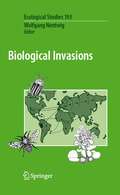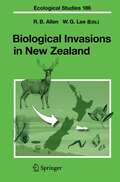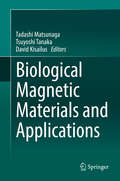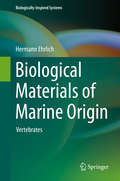- Table View
- List View
Biological Insulating Liquids: New Insulating Liquids for High Voltage Engineering
by Ernst Peter Pagger Norasage Pattanadech Frank Uhlig Michael MuhrThis book describes the state-of-the-art use of biological insulating liquids in detail. In recent years, more and more transformers filled with esters have been put into operation. This is because people recognize the benefits of ester liquids in terms of their fire safety (high flash and fire points) and environmental characteristics, judging from their biodegradability, their low CO2 footprint (only valid for natural ester) and their beneficial interactions with solid insulation, etc. One of the main reasons is that the water adsorption and absorption characteristics of these liquids are excellent and very different compared to mineral oil. The today’s discussion about climate change and global warming is an additional driver for using natural ester. Another advantage is that transformers filled with biological insulating liquids can operate with an overload of up to 150%. This is advantageous in the case of volatile energy generation from wind and solar power and in the supply of electrical energy for electromobility. Liquid inside electrical equipment is the lifeblood that serves both as a dielectric and a cooling medium. Some properties of these liquids differ from mineral oil, which had to be considered in the transformer design. The dielectric liquid is always in direct contact with transformer materials; therefore, the interaction should be very well understood, especially when retrofilling an existing mineral oil filled device. There are several natural ester fluids derived from various seeds and fruits on the market, and their properties may differ more or less. In the book, the most important properties of the different biological insulating fluids and mineral oil are compared. Ester fluids have already found their way into various standards. The condition of the device can be verified very well from the contents of the insulating liquids. For analysis and testing, the same equipment and devices that are commonly used for mineral oil are used for ester liquid. The chemical and physical behaviors of ester fluids compared to mineral oil are different. This must always be considered when interpreting test results stemming from ester fluids. The book is a guideline for students, original equipment manufacturers, users, laboratories and authorities in the use of biological insulating liquids.
Biological Interactions on Materials Surfaces: Understanding and Controlling Protein, Cell, and Tissue Responses
by Rena Bizios David A. PuleoSuccess or failure of biomaterials, whether tissue engineered constructs, joint and dental implants, vascular grafts, or heart valves, depends on molecular-level events that determine subsequent responses of cells and tissues. This book presents the latest developments and state-of-the-art knowledge regarding protein, cell, and tissue interactions with both conventional and nanophase materials. Insight into these biomaterial surface interactions will play a critical role in further developments in fields such as tissue engineering, regenerative medicine, and biocompatibility of implanted materials and devices. With chapters written by leaders in their respective fields, this compendium will be the authoritative source of information for scientists, engineers, and medical researchers seeking not only to understand but also to control tissue-biomaterial interactions.
Biological Invasions (Ecological Studies #193)
by Wolfgang NentwigThis new volume on Biological Invasions deals with both plants and animals, differing from previous books by extending from the level of individual species to an ecosystem and global level. Topics of highest societal relevance, such as the impact of genetically modified organisms, are interlinked with more conventional ecological aspects, including biodiversity. The combination of these approaches is new and makes compelling reading for researchers and environmentalists.
Biological Invasions and Its Management in China: Volume 1 (Invading Nature - Springer Series in Invasion Ecology #11)
by Fanghao Wan Mingxing Jiang Aibin ZhanThe book discusses invasive-species problems in agriculture, forests and aquatic ecosystems, highlighting the invasive mechanisms and management of the selected invasive species. Biological invasion has become a serious global ecological and economic problem that deserves particular attention from both government officials and scientists. This volume focuses on three key scientific areas: 1) population establishment and spreading mechanisms of the selected invasive species; 2) ecology adaptation, population growth, expansion and evolution of invasive species; and 3) impact of bio-invasion on the ecosystem structure and function at community and ecosystem levels. The presented research will result in techniques for better management of invasive species.
Biological Invasions and Its Management in China: Volume 2 (Invading Nature - Springer Series in Invasion Ecology #13)
by Fanghao Wan Mingxing Jiang Aibin ZhanThe book discusses invasive-species problems in agriculture, forests and aquatic ecosystems, highlighting the invasive mechanisms and management of the selected invasive species. Biological invasion has become a serious global ecological and economic problem that deserves particular attention from both government officials and scientists. This volume focuses on three key scientific areas: 1) population establishment and spreading mechanisms of the selected invasive species; 2) ecology adaptation, population growth, expansion and evolution of invasive species; and 3) impact of bio-invasion on the ecosystem structure and function at community and ecosystem levels. The presented research will result in techniques for better management of invasive species.
Biological Invasions in New Zealand (Ecological Studies #186)
by Robert B. Allen William G. LeeHuman colonization of New Zealand has dramatically altered the resident biota, introduced numerous alien organisms to these once remote islands, and exported local species to the world. This book reviews invasions, investigates what controls the success of invaders and studies the consequences for ecosystems both on land and offshore. The book tests current theories about the success of invaders and evaluates principles for effective management of biological invasions worldwide.
Biological Magnetic Materials and Applications
by Tadashi Matsunaga Tsuyoshi Tanaka David KisailusThis book addresses the biologically controlled synthesis of magnetic materials, and its applications in bio-inspired design and synthesis. It highlights several key aspects of biologically produced magnetic materials – (i) organisms that biologically synthesize and utilize magnetic materials; (ii) formation mechanisms; (iii) how these biological formation routes yield various phases and morphologies; and (iv) the resultant magnetic and structural properties – and describes diverse bio-inspired approaches to utilizing magnetic materials in applications ranging from semiconductor to health industries.In addition, the book discusses the recent industrial use of magnetic materials to develop scalable technologies that encompass protein displays, drug-delivery, biophysical separations, and medical diagnostics, as well as outlining future next-generation applications. As such, it offers valuable insights for all scientists interested in using multidisciplinary fields to overcome current obstacles, and in gaining multifaceted expertise in magnetic materials bionanotechnology.
Biological Magnetic Resonance: Volume 7 (Biological Magnetic Resonance #7)
by Lawrence Berliner Jacques ReubenWe are again proud to present an excellent volume of contemporary topics in NMR and EPR to the biological community. The philosophy behind the volume and the presentation of each chapter remains at the high level reflected in our earlier volumes: to be current, pedagogical, and critical. The first chapters, as always, address a subject related to in-vivo biology. Gabby Elgavish addresses NMR spectroscopy of the intact heart. lain Campbell and colleagues present a state-of-the-art description of NMR methods for probing enzyme kinetics in intact cells and tissues. Klaus Mobius and Wolfgang Lubitz have produced a thorough review of the principles and applications of ENDOR spectroscopy in photobiology and biochemistry including discussions of liquid and solid state ENDOR as well as CIDEP-enhanced ENDOR. The final chapter by Hans Vogel and Sture Forsen addresses a contemporary problem in inorganic biochemistry, namely cation binding to calcium binding proteins. We are pleased to announce that a special forthcoming volume will be devoted entirely to the subject of "Spin Labeling: Theory and Applications (3rd compendium)." A substantial degree of progress has occurred in this important area of ESR in biology since the last treatise on the subject in 1979. Lastly, we acknowledge our colleagues in the field who continue to support this excellent series both as subscribers and contributors. We pledge to continue servicing the community as long as the need exists.
Biological Management of Diseases of Crops: Volume 1: Characteristics of Biological Control Agents (Progress in Biological Control #15)
by P. NarayanasamyBiological disease management tactics have emerged as potential alternative to chemical application for containing crop diseases. Biotic and abiotic biological control agents (BCAs) have been demonstrated to be effective against diseases caused by microbial plant pathogens. Combination of biotic and abiotic agents leads to synergism and consequent improvement in the effectiveness of disease control. It is essential to assay the biocontrol potential of all isolates/species of fungal, bacterial and viral biocontrol agents by different techniques in vitro and under greenhouse and field conditions and to precisely identify and differentiate the most effective isolates from less effective ones by employing biological, immunological and nucleic acid-based assays.
Biological Management of Diseases of Crops: Volume 2: Integration of Biological Control Strategies with Crop Disease Management Systems (Progress in Biological Control #16)
by P. NarayanasamyBiological management of diseases of crops is influenced by the nature of interactions between the pathogens and other organisms and the plants. Due to development of resistance in pathogens to fungicides and bactericides, determination of compatibility of biotic biocontrol agents with chemicals is essential for selecting strains of biocontrol agents (BCAs) showing resistance to chemicals to effectively restrict use of the chemicals. Microbial plant pathogens and the antagonists present in the soil and on the plant surfaces are influenced by various cultural practices. It is possible to reduce disease incidence and intensity by crop sanitation and using appropriate rotational crops. Application of physical techniques involving the use of heat, solarization and irradiation has potential to reduce the pathogen population or weaken the potential of pathogens present in the seed, planting materials and soil.
Biological Materials of Marine Origin: Vertebrates (Biologically-Inspired Systems #4)
by Hermann EhrlichThis is the second monograph by the author on biological materials of marine origin. The initial book is dedicated to the biological materials of marine invertebrates. This work is a source of modern knowledge on biomineralization, biomimetics and materials science with respect to marine vertebrates. For the first time in scientific literature the author gives the most coherent analysis of the nature, origin and evolution of biocomposites and biopolymers isolated from and observed in the broad variety of marine vertebrate organisms (fish, reptilian, birds and mammals) and within their unique hierarchically organized structural formations. There is a wealth of new and newly synthesized information, including dozens of previously unpublished images of unique marine creatures including extinct, extant and living taxa and their biocomposite-based structures from nano- to micro – and macroscale. This monograph reviews the most relevant advances in the marine biological materials research field, pointing out several approaches being introduced and explored by distinct modern laboratories.
Biological Materials of Marine Origin: Invertebrates (Biologically-Inspired Systems #1)
by Hermann EhrlichBiological substances appeared in marine environments at the dawn of evolution. At that moment, the ?rst organisms acquired the ability to synthesize polymer chains which were the basis, in their turn, for the formation of the building blocks that fueled the so-called self-assembling process. They, in their turn, produced more complicated structures. The phenomenon of three main organic structural and sc- folding polymers (chitin, cellulose, and collagen) probably determined the further development and evolution of bioorganic structures and, of course, the organisms themselves. Allthethreebiopolymers,notwithstandingtheirdifferencesinchemical composition, have the common principles in their organization: nano?brils with the diameter 1. 5–2 nm, the ability to self-assemble, production of ?brillar and ?ber-like structures with hierarchical organization from nano—up to macrolevels, the ability to perform both the role of scaffolds and the templates for biomineralization and formation of the rigid skeletal structures. Chitin and collagen in particular played the determining role in the formation of skeletal structure in marine invertebrate organisms. These two biopolymers possess all the qualities needed to refer to them simul- neously as biological materials and biomaterials, the latter thanks to their successful application in biomedicine. The fact that modern science ?nds chitin and collagen both in unicellular and in multicellular invertebrates in fossil and modern species con?rms beyond a doubt the success of these biological materials in the evolution of biological species during millions of years. I realize that this success should be consolidated at genetic level and the detection of corresponding conserved genes must be the main priority.
Biological Membrane Ion Channels: Dynamics, Structure, and Applications (Biological and Medical Physics, Biomedical Engineering)
by Shin-Ho Chung Olaf S. Anderson Vikram V. KrishnamurthyThis book deals with recent breakthroughs in ion-channel research that have been brought about by the combined effort of experimental biophysicists and computational physicists, who together are beginning to unravel the story of these exquisitely designed biomolecules. With chapters by leading experts, the book is aimed at researchers in nanodevices and biosensors, as well as advanced undergraduate and graduate students in biology and the physical sciences.
Biological Micro- and Nanotribology: Nature’s Solutions (NanoScience and Technology)
by Matthias Scherge Stanislav S. GorbBy employing a combination of approaches from several disciplines the authors elucidate the principles of a variety of biomechanical systems that rely on frictional surfaces or adhesive secretions to attach parts of the body to one another or to attach organisms to a substrate. This account provides an excellent starting point for engineers and physicists working with biological systems and for biologists studying friction and adhesion. It will also serve as a valuable introduction for graduate students entering this interdisciplinary field of research.
Biological Microtechnique
by Jeremy SandersonA completely new practical guide to both new and classical methods of slide-making which is easy-to-read and easy-to-understand. Biological Microtechnique contains a wealth of practical detail which will provide a firm grounding in preparative methods for light microscopy.
Biological Microtechnique
by Jeremy SandersonA completely new practical guide to both new and classical methods of slide-making which is easy-to-read and easy-to-understand. Biological Microtechnique contains a wealth of practical detail which will provide a firm grounding in preparative methods for light microscopy.
Biological Nanostructures and Applications of Nanostructures in Biology: Electrical, Mechanical, and Optical Properties (Bioelectric Engineering #Vol. 2)
by Mitra Dutta Michael A. StroscioBiological Nanostructures and Applications of Nanostructures in Biology: Electrical, Mechanical, and Optical Properties contains reviews and discussions of contemporary and relevant topics dealing with the interface between the science and technology of nanostructures and the science of biology. Moreover, this book supplements these past groundbreaking discoveries with discussions of promising new avenues of research that reveal the enormous potential of emerging approaches in nanobiotechnology. The topics include: - Biomedical applications of semiconductor quantum dots, - Integrating and tagging biological structures with nanoscale quantum dots, - Applications of carbon nanotubes in bioengineering, - Nanophysical properties of living cells, - Bridging natural nanotubes with fabricated nanotubes, - Bioinspired approaches to building nanoscale devices and systems, - Hairpin formation in polynucleotides. This state-of-the-art survey of key developments in nanotechnology - as they apply to bioengineering and biology - is essential reading for all academics, biomedical engineers, medical physicists, and industry professionals wishing to take advantage of the latest developments and highly-promising discoveries in nanoscience underlying applications in bioengineering and biology.
Biological Nitrogen Fixation: Proceedings of the 15th International Nitrogen Fixation Congress and the 12th International Conference of the African Association for Biological Nitrogen Fixation (Current Plant Science and Biotechnology in Agriculture #42)
by Felix D. Dakora Samson B. M. Chimphango Claudine Elmerich William E. Newton Alex J. ValentinePoverty is a severe problem in Africa, Asia, South America and even in pockets of the developed world. Addressing poverty alleviation via the expanded use of biological nitrogen fixation in agriculture was the theme of the 15th International Congress on Nitrogen Fixation. Because nitrogen-fixation research is multidisciplinary, exploiting its benefits for agriculture and environmental protection has continued to attract research by diverse groups of scientists, including chemists, biochemists, plant physiologists, evolutionary biologists, ecologists, agricultural scientists, extension agents, and inoculant producers. The 15th International Congress on Nitrogen Fixation was held jointly with the 12th International Conference of the African Association for Biological Nitrogen Fixation. This joint Congress was hosted in South Africa at the Cape Town International Conv- tion Centre, 21–26 January 2007, and was attended by about 200 registered participants from 41 countries world-wide. During the Congress, some 100 oral and approximately 80 poster papers were presented. The wide range of topics covered and the theme of the Congress justifies this book’s title, Nitrogen Fixation: Applications to Poverty Alleviation.
Biological Nitrogen Fixation and Beneficial Plant-Microbe Interaction
by Fernando González-Andrés Euan JamesThis book covers the most recent advances in all the topics with which researchers and professionals need to be familiar in order to obtain a better understanding of, and to better exploit, beneficial plant-microbe interactions. The use of microorganisms for agriculture and environmental applications is gaining importance worldwide to improve crop performance, but also for other environmental applications, such as bioremediation in chemically polluted soils. The search for an equilibrium between fundamental and applied aspects makes this book useful for professionals at various levels in the value chain of the “microbial biofertilizers”. Challenges of comercializing biofertilizers involve efficiency of the products and safety for human health and the environment, topics that have paid central attention in this book. Students, scientists and biofertilizers developers will find updated and comprehensive information about the different aspects to be considered to address a successful introduction of biofertilizers in sustainable agriculture and environmental actions.
Biological Nitrogen Fixation, Sustainable Agriculture and the Environment: Proceedings of the 14th International Nitrogen Fixation Congress (Current Plant Science and Biotechnology in Agriculture #41)
by Claudine Elmerich Min Lin William E. Newton Zhe-Xian Tian Yi-Ping WangThe 14th International Nitrogen Fixation Congress was held in Beijing, China from October 27th through November 1st, 2004. This volume constitutes the proceedings of the Congress and represents a compilation of the presentations by scientists from more than 30 countries around the World who came to Beijing to discuss the progress made since the last Congress and to exchange ideas and information. This year marked the 30th anniversary of the first Congress held in Pullman, Washington, USA, in 1974. Since then, this series of Congresses has met five times in North America (three in the United States and once each in Canada and Mexico), once in South America (Brazil), four times in Western Europe (once each in Spain, The Netherlands, Germany and France), once in Eastern Europe (Russia), and once in Australia; and now for the first time in Asia. China was a most appropriate choice because China is a big country with the largest population in the World, about 1. 3 billion people, which is about 22% of the World’s population. It is traditionally an agricultural country, even though China has only 7% of the available farming land. This situation explains why agriculture and its productivity are major issues for the Chinese people, its government and the scientists in the field.
Biological Performance of Materials: Fundamentals of Biocompatibility, Fourth Edition
by Jonathan BlackBioengineers need a thorough grounding in biocompatibility - the biological performance of materials. Until now, there were no publications suitable for a neophyte in the field; prior publications were either not comprehensive or focused on rather narrow interests. Drawing on the author's 35 years of experience as a teacher, researcher, and consult
Biological, Physical and Technical Basics of Cell Engineering
by Gerhard M. Artmann Aysegül Artmann Azhar A. Zhubanova Ilya DigelThis book presents and discusses recent scientific progress on Cell and Stem Cell Engineering. It predominantly focuses on Biological, Physical and Technical Basics, and features new trends of research reaching far into the 21st century.
Biological Processing of Solid Waste
by Sunil Kumar Zengqiang Zhang Mukesh Kumar Awasthi Ronghua LiOffering a comprehensive approach, this title covers fundamentals, technologies, and management of biological processing of solid waste. It discusses kinetic modeling and synergistic impact evolution during bioprocessing of solid waste, environmental impacts such as greenhouse gas emission from biological processing of solid waste, energy recovery from solid waste, and biodrying of solid waste. It also presents cases and challenges from different countries, successful business models, and economic analyses of various processing options. Aimed at researchers and industry professionals in solid and hazardous waste management, this title offers a wealth of knowledge to help readers understand this increasingly important area.
Biological Processing of Solid Waste
by Sunil Kumar, Zengqiang Zhang, Mukesh Kumar Awasthi, and Ronghua LiOffering a comprehensive approach, this title covers fundamentals, technologies, and management of biological processing of solid waste. It discusses kinetic modeling and synergistic impact evolution during bioprocessing of solid waste, environmental impacts such as greenhouse gas emission from biological processing of solid waste, energy recovery from solid waste, and biodrying of solid waste. It also presents cases and challenges from different countries, successful business models, and economic analyses of various processing options. Aimed at researchers and industry professionals in solid and hazardous waste management, this title offers a wealth of knowledge to help readers understand this increasingly important area.






















